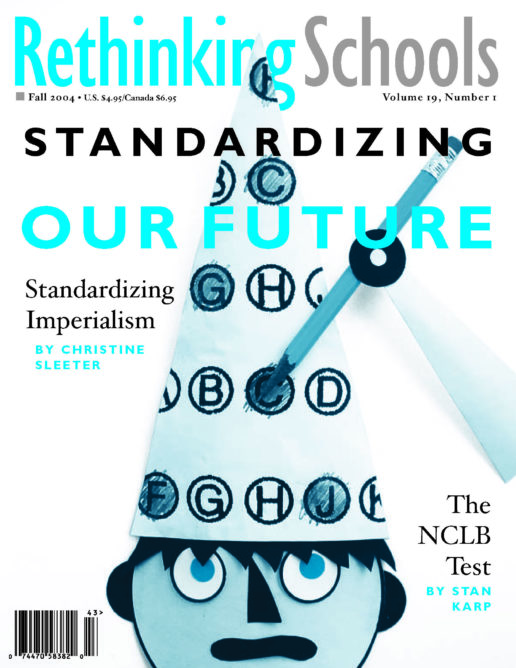Picture Perfect
A perfect prompt for talking about images of women in the media
Picture Perfect. PicturePerfect Productions. Video. 40 minutes. Produced and directed by Carol Tizzano. 216-297-0622. ctano1311@sbcglobal.net
While I hate to admit this in Rethinking Schools, I subscribe to Glamour. I watch my weight. I often hit the Clinique cosmetic counter during “bonus week” and have drawers full of sample-sized lotions and mascaras as proof. When I wake up and don’t feel adequately focused for the teaching day ahead, I think to myself, “dress better than you feel.” Somehow a good outfit works like a magical scaffold for me, substituting for confidence until my real skill and expertise catch up. I even bought Barbie dolls for my nieces. Either I am the last person on earth who should be reviewing Picture Perfect ; or it’s a documentary made explicitly for “girls” like me.
Picture Perfect , a 40-minute documentary by Carol Tizanno examines the pervasive pains and pressures of growing up female in the United States on a steady diet of airbrushed images of feminine beauty in magazines, television shows, music videos, and advertisements. Mixing clips like Britney Spears’ stomach with late-night television ads for rapid weight-loss programs and punctuating a fast-paced parade of provocative pictures of thin models and sexualized stars with interviews with real women of different ages and races, Picture Perfect is the perfect stimulant for thought and conversation.
The film begins with a photograph of a baby girl. As we watch her age through a succession of photographs, her voice narrates the ways in which her looks tortured her along the way. We meet more women — each with a particular concern about her looks, from the width of her nose to her height to the size of her thighs — and hear one lament, “I wasted a lot of good years” in thoughts and obsessions about her body.
From there, the film continues to trouble the idea of physical perfection, beginning with ads and content in teen and women’s magazines and moving quickly through related issues like images of women in music videos and television shows, the pressure to be sexy at all times, the quest for the perfect weight, eating disorders, money spent on make-up and hair products, the impact of Barbie dolls on girls, and the two available roles for girls and women: good girl or slut.
With images, interview clips, and haunting statistics like “80 percent of 4th grade girls are on a diet” marching across the screen in rapid succession, there is much to discuss in this film. Perhaps too much. Each segment could easily become its own full documentary. While the filmmaker states that the film is suitable for all ages, not all segments are suitable for young children.
Additionally troubling are the implicit heterosexual assumptions about viewers, as well as one interviewee’s comment that rap artists (read black men) were the first to sing derogatory lyrics about women. The film ends with both useful and poignant advice about disrupting the media assaults on women and girls and worn-out platitudes like “beauty comes from within.”
I watched this film several times with preservice teachers — straight, gay, women, men, black, white, and Latina. In the conversations that followed, we talked back to the film about the fun of fashion, the age-old joy of people dressing themselves up and looking and feeling good, the ways that some fashion magazines are using models of a variety of sizes and creating a more complicated definition of beauty. We talked about the freedom of sexual expression and the dangers of censorship. We brainstormed a wide array of possibilities for using this film in connection with literature that asks timeless questions about beauty (like Toni Morrison’s The Bluest Eye ), with statistics about marketing and globalization, and with nutrition information that illuminates the dangers of eating disorders as well as the health effects of obesity. We agreed that the search for unobtainable perfection that accompanies growing up female in the United States is a serious problem. Picture Perfect is a valuable conversation starter and provides an oportunity to begin addressing that problem.

